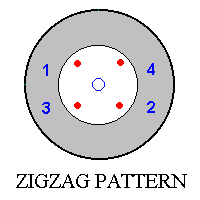Replacing Your Disc Brake Pads
*HARD*
Some brake systems have audible, electronic, or tactile wear sensors. With the first type, a high pitched squeal will be heard when the pads should be replaced. The second type of sensor utilizes a dashboard indicator to warn that pad replacement is necessary. The last method indicates worn pads by sending a pulse through the brake pedal.
If your disc brake wear sensor or visual inspection reveals worn pads, replace them with new pads. If additional mechanical or hydraulic problems are observed, have them immediately repaired by a professional automotive technician before replacing the pads.
Replace your disc brake pads with the following general procedure:
- Park the vehicle on level ground with the engine OFF, the parking brake engaged, and the transmission in PARK (for automatic) or REVERSE (for manual). Raise the hood.
- Open the master cylinder reservoir, as indicated in Checking Your Brake Fluid Level, and remove some brake fluid using a siphon or large rubber squeeze bulb. Do not get any air in the fluid. Reduce the fluid level to half full and replace the reservoir cap tightly. Discard the removed brake fluid. If your owner's manual recommends a different bleeding approach, follow it. Close the hood.
- Loosen the lug nuts on both front wheels with a tire iron. Elevate the vehicle front end on safety stands and block the rear wheels. Remove the lug nuts from the studs and both front wheels from the vehicle.
- Loosen and remove the brake pad locating pins on one caliper. Leave the other connected to the rotor to serve as a model.
- Swing the caliper away from
the rotor and remove the inner and outer pads from one caliper.
Since the caliper is attached to the brake system by a brake hose, suspend the caliper from the car frame using a wire. Do not allow the caliper to hang from brake hose; it could be torn. - Inspect the condition of the pin insulators and sleeves. If necessary, install new pin insulators and sleeves.
- Use a small wooden block and C-clamp to force the caliper piston back into its bore. The block should be placed between the piston and C-clamp. Tighten the clamp, then loosen it.
- Install the new brake shoes on the caliper. Consult your owner's manual for replacement part specification or equivalent. Note that the inner and outer pads are not interchangeable.
- Place the caliper over the brake rotor and slide the caliper over the locating pins. Tighten the pins according to specifications.
- Repeat previous six steps for remaining caliper(s).
- Remount both front wheels. Tighten the lug nuts on each wheel by hand in
an even, but alternating zigzag, pattern.
Lower the car to the ground enough for the tire tread to make contact. Finish tightening the lug nuts to the correct specification. Remove the safety stands and wheel blocks. - Fill your master cylinder reservoir to the FULL or MAX level with new brake fluid.
- Test the firmness of your brake pedal. If firm, test the brake pads at low speed. Correct any problems if they occur.
As brake pads wear, the disc caliper will reposition itself on the mounting bolts. The brake shoes are self-adjusting with each use of the brakes. As the pads wear and become thinner, they still remain they same (slight) distance off the rotor surface when the brakes are not in use. This is because of the slight friction force caused by the square-edged rubber piston seals flexing back to their original position. No maintenance is needed besides regular replacement.

